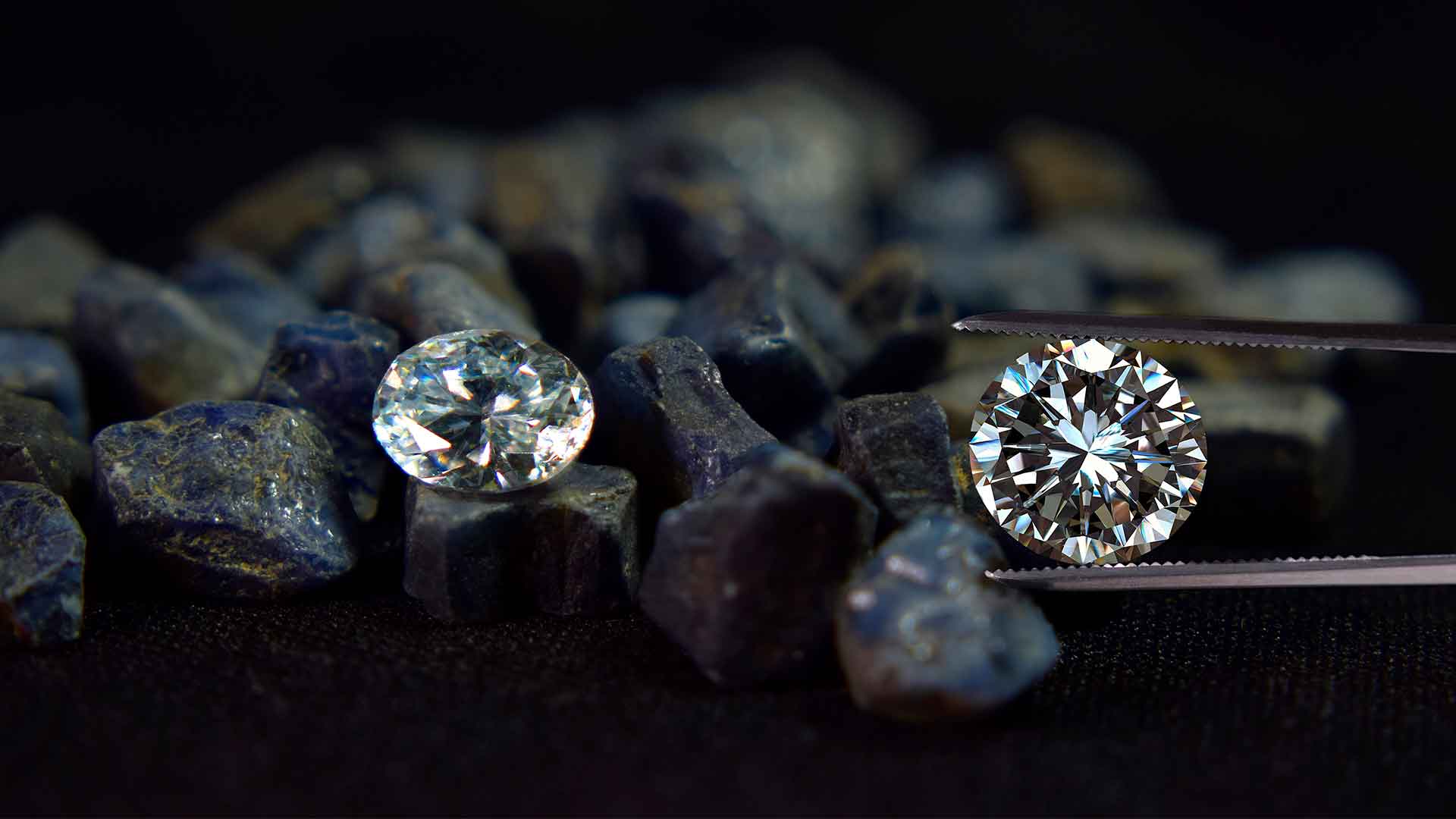
BORON AND DIAMONDS
Diamonds contain boron! Borophene, also known as the “boron butterfly”, has been found on top of diamonds’ surface with high heat in vacuum conditions. This material can be used to create super strong magnets and other advanced materials for today’s technology-driven world.
It is also not clear how boron became incorporated in the diamond lattice, but it may be due to impurities or an unknown crystal growth mechanism.
Diamonds can be found all over the world but it takes a trained eye to spot them from natural materials such as quartz or topaz. When you compare its content in a diamond with emerald, they are roughly comparable. The difference is that most people don’t know about these diamonds because they aren’t as easy to spot when mining or cutting stone as their green counterpart! When an expert looks for tiny crystals in the rough they can tell that a diamond is present just from their shape and density profile.
DIAMONDS WITH BORO-SILICATE
Diamonds with boro-silicate are very rare, but they do exist! The presence of boro-silicate in the middle of a diamond is an indication that it will be more resistant to breakage. They can be easily spotted by their light green hue – as opposed to emerald’s deep green color. Diamond mines are among the most notable users, where boron-containing ores extracted for their diamonds can be crushed to recover valuable gemstones.
BORON DOPED DIAMOND
Boron-doped diamond (BDD) electrodes present several notable properties, such as high stability and durability, as well as a high surface area. The surface of these electrodes is amorphous carbon with boron-doped (BD) clusters embedded in it. With their durability and stability properties under various conditions, boron-doped diamonds are a valuable resource that can be used in many different fields and applications.
BORON AS CATALYTIC PROMOTER FOR DIAMOND
The catalytic properties of diamonds make them ideal for use in hydrogen fuel cells – where gas molecules are introduced to the anode to produce electricity from their chemical composition and the properties that accompany them. The high surface area of these electrodes is ideal for use as catalysts, such as in water filtration and purification, where the boron clusters can react with hydrogen peroxide to produce a highly reactive free radical that breaks down organic pollutants.
The boron on diamond could be used for applications such as super strong magnets, or other advanced materials for today’s technology-driven world. The borophene can also be used to create a surface that is resistant to corrosion and abrasion because of its hardness and chemical inertness against water.
BORON AND PLATINUM
It plays a role in enhancing the catalytic performance of supported platinum catalysts by extending the active surface area of platinum. For the non-oxidative dehydrogenation of n-butane, the platinum catalysts are used in the presence of boron which is used as a promoter. As a promoter, it can increase the activity of platinum-based catalysts. Platinum is an effective catalyst for dehydrogenation and metathesis reactions due to its ability to form bonds with hydrocarbons by covalent interactions. Unfortunately, exposure to high temperatures often leads to platinum deactivation which results in loss of selected products and an enormous increase of coke formation.
So, boron additives can be used to mitigate such effects by promoting platinum activity while still maintaining its selectivity for desired reactions. The use of its additives is a recent development in catalytic process design which has seen commercial success as well as academic attention with the researchers working on the production of USP-grade hydrogen peroxide by the hydrolysis of peracetic acid.
The researchers in this case study were interested to see if boron additives would be helpful for their research, so they determined that the addition of 0.08 wt% B and 0.09 wt% Fe improved platinum activity.
BORON AND GOLD
Borates have a wealth of uses in metallurgy and gold refinement. Aside from specialized uses Borates are an essential component of the production and refinement of many items, including gold. Borates are a diverse family of chemicals with many uses, from refining gold to creating strong magnets. It is found in precious minerals and metallurgy.
Photoelectron spectroscopy and density-functional theory are combined to investigate the electronic and structural properties of a series of boron and gold alloy clusters which resulted as a consequence of the hydrogenation reaction.
Hydrogen, boron, and gold are mixed in a furnace to produce novel clusters which have been examined by photoelectron spectroscopy and density-functional theory.
Different cluster compositions with different shapes may be prepared through variations on this technique that can potentially improve their performance for catalytic applications which brings up a conclusion that boron and gold density-functional theory is a quantum mechanical computational technique used in physics and chemistry to study the electronic structure of molecules, crystals.
It’s combined with electron spectroscopy to investigate boron clusters grown on gold surfaces that can be potentially applied as catalysts for chemical reactions or photocatalysis.
The metal cluster was first hydrogenated using the reaction of mercury and hydrogen to form a gold “surface” cluster.
The clusters were then exposed to boron vapor, which would condense on the surface and react with it in a way that led to the formation of more complex structures – including long chains. This technique can be used for catalytic applications such as chemical reactions or photochemical reactions, both of which could have applications in energy production, conversion, and storage.
The technique was first used for spectroscopy – a physics and chemistry technique that studies the electronic structure of molecules by shining light on them.
BORON AND SILVER
In DOPED SILVER
To prepare boron-doped silver nanosponges which can be defined as silver nanospheres coated with boron, this technique was then used to study the chemical reactions of certain molecules like hydrogen peroxide by reacting it with a silver surface and exposing it to boron vapor. This allows for selective spectroscopy which can be useful in many aspects such as tracing pollutants or studying biochemical changes within cells which are caused by hydrogen peroxide.
Another property of it is its ability to adsorb hydrogen atoms, this can be very useful for storage in fuel cells as well as other uses including electrochemical processes such as water desalination or energy production. Adding a small amount of it reduces corrosion. Benefiting from their interconnected porous structures and composition effect, the B–Ag NSs achieve excellent NRR performance and stability.
The boron-doped silver with a boron content of 15 at%, can be converted into a superconductor, which has properties of metals to conduct electricity without resistance and at the same time.
This means that it can be used in three dimensions for materials engineering with its high strength-to-weight ratio for use as metallurgical additives or catalysts.
In SILVER ALLOY
- Another important property is that the silver and boron together like this do not corrode even when exposed to seawater.
- However, it is not all rosy for the boron-silver alloy. The material becomes brittle in low temperatures and its electrical conductivity decreases at high frequencies and this can be a problem as most of our modern electronic devices operate on these same frequency ranges so increased research into making them preciously useful involves reducing the brittleness and increasing the electrical conductivity.
IN GEMS
The form of boron you see when it’s sitting on your hand at room temperature or embedded into an expensive gemstone like an emerald. It has been speculated about this that it may have some connection to the bonding of carbon atoms.
Danburite is a calcium boron silicate mineral with a chemical formula of CaB2(SiO4)2. Its crystal symmetry and form are similar to topaz; however, topaz is calcium fluorine-bearing nesosilicate. emerald consists of boron naturally forming its precious composition. If the color is found in a yellow hue, it may be due to natural or artificial irradiation.
Boron-containing minerals are numerous and include spodumene (LiAlSi)O(F,OH); kunzite; lepidolite ((KMg)(AlSi)O(Cl))
Opals are a thin, sometimes translucent mineraloid with an internal structure that produces its play of colors from refracted light; they typically consist largely or entirely of water trapped within a silica framework and range in color from clear through white, gray, red, etc. and it is naturally found in the gem.
Boron is an element, typically classified as a metalloid. It has one naturally occurring and stable isotope (11B). Its atomic weight of approximately 11 g/mol makes it about as heavy as silicon but lighter than fluorine or carbon. Also, it is naturally found in ruby and amethyst and its atomic radius is only about one-third of that found in fluorine or chlorine. Boron and ruby cantilevers are defined as those with the highest Young’s modulus found in nature.





